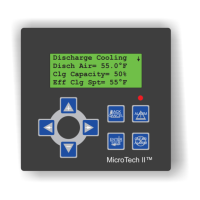Page 78 OM 780-2
Interstage Timers
The CSM uses the Stage-Up Delay Time and Stage-Down Delay Time variables for transition between stages. Different
stage-up and stage-down delay times may be entered for each pump stage if desired. These stage timers start counting down
after the Cooling Load Pump Speed crosses the current Stage-Up/Down % setpoint. Pump stage changes (up or down) will
occur when the timer reaches zero. These timers are reset (set back to their full value) for three reasons;
• The Cooling Load Pump slips back across the current Stage-Up/Down % setpoint.
• A chiller stage change.
• The timer reached zero and the CSM performed the pump stage change.
When reset occurs on either timer, both timers reset and start counting down. The timers are reset after a chiller is enabled
or disabled so that the system has a chance to stabilize after a chiller’s flow valve opens or closes.
Sequencing Logic
The first cooling load pump (the pump with the lowest runtime) is turned on when the CSM has been set to On (Occupied)
or the Recirculate Mode has been turned on. All cooling load pumps are turned off when the CSM is set to Off
(Unoccupied) and the Recirculate Mode has been turned off.
Stage-Up Control: The CSM enables the next pump when the differential pressure across the cooling load is too low. This
stage-up occurs whenever the following two conditions are satisfied:
1. The pump speed control PI loop has commanded the Cooling Load VFD Speed higher than the current pump’s Stage-
Up % setpoint.
2. Condition 1 above has been true for period of time longer than the current pump stage’s Stage-Up Delay Time (with no
chiller stage change).
Any time multiple VFD controlled pumps are running the CSM will always send the same signal to all VFDs so that all
pumps operate at the same speed. When a new pump is enabled, its VFD will have the same speed setting as the previously
running pumps. Initially the pump will run but not have enough speed to overcome the pressure differential created by the
other operating pumps, as the pump accelerates it will generate enough pressure to produce flow. The acceleration rate of
the VFDs must be set fast enough so that the newly enabled pump begins to generate flow in a reasonable amount of time to
prevent overheating of the pump. The resulting acceleration time (time from zero to maximum frequency) of the VFD must
be less that the Pump Status Check Delay Time variable to avoid nuisance Cooling Load Pump #X Fail alarms
As the new pump’s flow is added to the system, the pumps will create more flow than required by the cooling loads, which
will increase the loop differential pressure above the setpoint. The pump control PI loop will notice the increased loop
differential pressure and decrease the speed of the pumps.
Stage-Down Control: The CSM stages down when the differential pressure across the cooling loads is too high. This
occurs whenever the following two conditions are satisfied:
1. The pump speed control PI loop has commanded the Cooling Load VFD Speed lower than the current pump’s Stage-
Down % setpoint.
2. Condition 1 above has been true for period of time longer than the current pump stage’s Stage-Down Delay Time (with
no chiller stage change).
Pump Failure
After the CSM enables any pump, it continually checks each pump’s status to verify that it is operating. If the CSM finds
that a pump is not operating (switch open), it immediately starts a timer, which is set equal to the Pump Status Check Delay
Time variable (default is 30 seconds). If the status returns before the timer expires, the timer resets and stops, and the
system continues to operate normally. Be sure that the acceleration time of the pump’s VFD is less than the Pump Status
Check Delay Time or the pump may not generate enough flow to satisfy the flow proving device before the timer expires. If
the timer expires before the status returns:
• The pump with the next lowest runtime is enabled.
• The Cooling Load Pump #X Fail manual reset alarm occurs. The pump will not run again until the operator clears
the CSM alarms.
• The failed pump’s output is de-energized.
If all pumps have failed, the No Chilled Water Flow alarm occurs and the system shuts down. As a result, all pump outputs
are de-energized.

